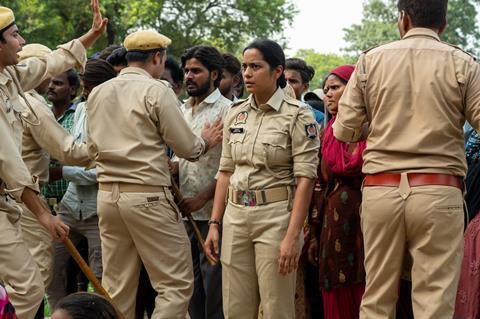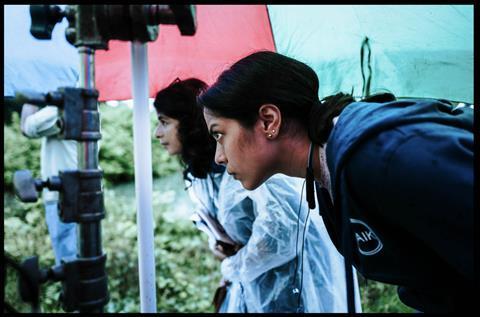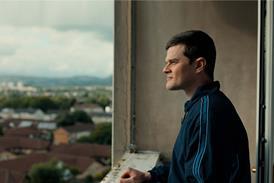Whether working on the railways or planning around monsoons, there was a freedom to filming in India with a dedicated local crew, the UK producer of Sandhya Suri’s Santosh tells Screen.

”We could do things in India that you couldn’t do anywhere else,” says UK producer James Bowsher of filming Sandhya Suri’s Hindi-language Un Certain Regard title Santosh in north India last year.
Bowsher, who produces with Mike Goodridge via the UK’s Good Chaos, is referring to a sequence in the drama that required the use of a real train as well as a station and track. A “military-style operation” was carried out, involving several requests to Delhi’s chief controller of railways and a local controller before approval was granted.
“We were eventually given a train on the tracks going up and down the actual Indian national railway,” reveals Bowsher.
Suri’s fiction debut follows a woman, played by Shahana Goswami, who becomes a police officer following the death of her husband. Good Chaos came on board as lead producer in late 2022, after another UK outfit had reached “the end of the road” with the project, joining France’s Balthazar de Ganay and Alan McAlex of India’s Suitable Pictures. The budget came in at just over $2.5m (£2m) and included funding from the BFI, BBC Film, Germany’s ZDF and France’s CNC — the latter two through co-producers Razor Film and Haut et Court respectively.
Mumbai-based producer Suitable Pictures proved a “class act”, says Bowsher, helping to navigate India’s permit restrictions. This included Santosh not being set in a named city due to its portrayal of local police forces. “The easiest way was to shoot things around the city that everyone can recognise,” the producer explains, “but without it being so clear cut that people go, ‘Wait, you’ve now completely placed us here.’”
Real locations

Santosh filmed over 45 days between August and October 2023 to hit the sweet spot between the end of monsoon season and the start of Diwali celebrations. But even with such strategic timing, the production was hit with flooding on the second day of the shoot. “We had to rearrange the whole schedule for that first week [because of the rain],” says Bowsher. “But again, that’s sort of the virtue of India as you can do that. In other countries, it might have been hard to move around the structure.”
There was also the consideration of soaring temperatures, often ranging between 42°c and 44°c, to which the European crew on the shoot were less accustomed. For the most part, air conditioners and fans proved “a saving grace”, says Bowsher.
Shot entirely on location, Suri and her team were determined to film in as many real locations as possible, including police barracks and the aforementioned train. As a result, distances between sites could be expansive and days long. “But I think the crew appreciated what we were trying to do by shooting on location and trying to be as authentic as possible,” suggests Bowsher.
Solid crew
The crew on Santosh were mostly Indian — including production designer Devika Dave and supervising producer Heeral Gandhi — with the production finding experienced, available crew in abundance. While the local labour unions are strong, crew rates are generally lower than western industries. “Equally, Suitable Pictures were good at making sure we still paid everyone fairly and they were given the appropriate amount,” adds Bowsher.
The producer also notes the commitment of the Indian crews to knowing the script (“better than most western crews”).
“They had a lot of love for the project and really bought into the vision of the script,” Bowsher says.
Apart from the inclusion of two rest days a week — a 12-hour, six-day working work is often industry standard in India — the team learnt to adapt to the country’s style of production. For example, crews were used to solving problems through additional labour, common on Bollywood juggernauts but less so on independent European productions working with smaller budgets.
“We eventually had a large infrastructure following us because that’s the way Indian crews work best,” says Bowsher. “The crews felt more comfortable when they were being given clear, delineated roles than being asked to do something that wasn’t their responsibility.”
The production did not apply for Uttar Pradesh’s Film Subsidy, worth 25% of daily production spend on Hindi-language films as the team was keen to avoid any further filming stipulations from the local authorities. “It would have given more chances for more people to feed into what we had to do in our movie. We wanted to give Sandhya the most authentic experience possible,” says Bowsher.















![[Clockwise from top left]: Paul Thomas Anderson, Chloe Zhao, Ryan Coogler, Park Chan-wook](https://d1nslcd7m2225b.cloudfront.net/Pictures/274x183/9/0/0/1467900_writerdirectors_192733.jpg)





![[Clockwise from top left]: Paul Thomas Anderson, Chloe Zhao, Ryan Coogler, Park Chan-wook](https://d1nslcd7m2225b.cloudfront.net/Pictures/100x67/9/0/0/1467900_writerdirectors_192733.jpg)


No comments yet